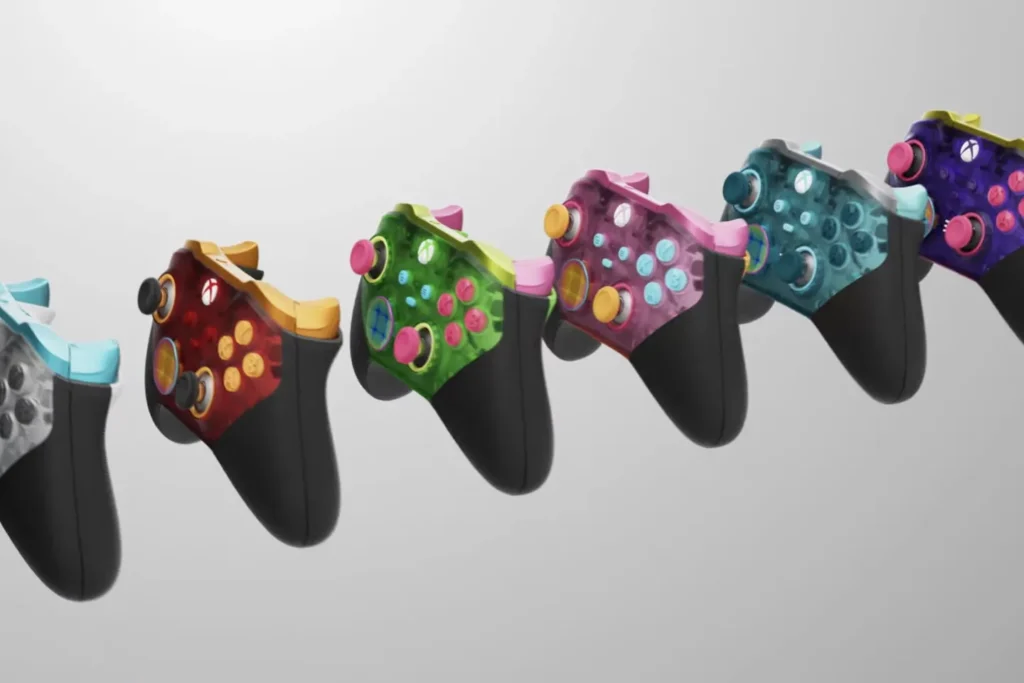For years, the Xbox Elite Wireless Controller has been a benchmark for premium gaming peripherals, combining high-end materials, customizable features, and robust build quality. As the go-to controller for serious gamers, it has set the standard for what a pro-level gaming accessory should be. Recently, Microsoft has added a new layer of excitement to the Elite controller experience by introducing translucent options through its Xbox Design Lab. While this might seem like a mere cosmetic update at first glance, the addition of translucent colors is a meaningful evolution that offers more than just aesthetic appeal.
Nostalgia Meets Modernity
To understand the impression of these new translucent options for the Xbox Elite Wireless Controller, it’s essential to take a brief look back at the history of translucent designs in gaming. Microsoft is no stranger to the allure of see-through plastics. Fans of the original Xbox will remember the coveted Duke and S controllers in their various translucent forms, often called Halo editions or Crystal editions. These designs offered a glimpse into the inner workings of the hardware, transforming a standard gamepad into something with a sense of personality and history.
Even before the Xbox era, the late ‘90s and early 2000s saw a wave of translucent consoles and controllers across the industry, from Nintendo’s Atomic Purple Game Boy Color to the see-through DualShock controllers for the PlayStation. These designs didn’t just stand out on store shelves; they became icons of their respective brands, emblematic of an era when gaming hardware was moving from mere functionality to cultural objects with a distinct visual identity.
By offering translucent options for the Elite controller, Microsoft taps into this well of nostalgia while simultaneously reinforcing its commitment to customization and quality. It’s a clever nod to the past that speaks to the current market’s hunger for personalization.
The translucent color options available through Xbox Design Lab include a range of hues like “Smoke Black”, “Glacier Blue”, and “Crimson Red”, among others. Each shade offers varying levels of transparency, allowing players to choose just how much of the internal mechanics they want to reveal. This choice is more than skin-deep. The translucent shell, with its slight gloss and visibility into the inner framework, transforms the controller into an interactive art piece. It blurs the line between functionality and aesthetics, making the hardware itself part of the gaming experience.
In terms of functionality, the new color options do not compromise the core features of the Elite controller. Every customization option that makes the Elite line special—adjustable tension thumbsticks, interchangeable paddles, and precision-tuned triggers—remains intact. In fact, the translucent design enhances the experience by allowing players to see the components that they can tweak and personalize. When you’re adjusting the trigger locks or swapping thumbsticks, the visual feedback of seeing how these parts interlock adds a layer of satisfaction to the process.
Additionally, these translucent designs are coupled with the robust customization options available through the Xbox Design Lab. Players can mix and match colors, choose different finishes for the buttons and D-pad, and even add laser-engraved text. This means that no two controllers need to look exactly alike, making it a true reflection of the player’s style. With the introduction of these new translucent shells, players are given an even greater canvas for self-expression.
One of the most intriguing aspects of offering translucent designs is the psychological impression it may have for avid players. The transparency—literal and metaphorical—creates a sense of openness and honesty. It’s as if Microsoft is saying, “Here’s everything we’ve put into making this controller great. We’re not hiding anything.” This openness fosters a deeper connection between the user and the device. There’s something undeniably captivating about seeing the hidden circuits and mechanisms that make the controller function.
Moreover, the element of choice plays a significant role in creating a sense of ownership. By allowing players to choose from a range of translucent options, Microsoft empowers its customers to be co-creators in the final product. The controller becomes more than just a tool for playing games—it becomes a personal artifact that carries the player’s unique fingerprint.
Impression
The addition of translucent options also sends a message about the evolution of the Xbox brand. Over the past few years, Microsoft has focused heavily on creating a cohesive ecosystem that extends beyond traditional hardware sales. With services like Xbox Game Pass, cloud gaming through xCloud, and cross-platform integration, the company is positioning itself as a hub for gaming rather than just a console manufacturer.
Introducing new customization options for the Elite controller—particularly through the Xbox Design Lab—is an extension of this strategy. It shows that Microsoft understands the multifaceted nature of today’s gamers. They’re not just looking for the best hardware or the most games; they want experiences that feel personal and tailored. Offering translucent controllers is a way to deepen engagement, encouraging players to invest more emotionally and financially in the Xbox ecosystem.
While the translucent color options are a welcome addition, it’s worth considering whether this update is enough to maintain the Xbox Elite Wireless Controller’s edge in the market. The Elite controller has faced some criticism in the past for durability issues, particularly with stick drift and faulty bumpers. While Microsoft has addressed these concerns to some extent, the core design remains largely unchanged. The introduction of new color options, however visually appealing, does not tackle these longstanding issues.
For some, this might raise the question of whether Microsoft is focusing on aesthetics at the expense of function. A translucent shell won’t solve mechanical problems, and if the controllers continue to suffer from durability concerns, no amount of customization will make up for the frustration of a malfunctioning device. In this light, the translucent options might be seen as a cosmetic distraction rather than a substantive improvement.
Looking ahead, it will be interesting to see how Microsoft continues to evolve the Xbox Design Lab and its controller offerings. The translucent options are a strong addition, but there’s potential for even more innovation. Future iterations could include customizable backlighting for the buttons or modular parts that allow players to switch out components with ease. Microsoft could also consider expanding the Design Lab to include other accessories, such as headsets or even console skins, to create a more comprehensive personalization experience.
Ultimately, the translucent options for the Xbox Elite Wireless Controller represent more than just a superficial update. They are a statement of intent, signaling that Microsoft is listening to its community and willing to embrace both nostalgia and modernity. The move reaffirms the brand’s commitment to making the Xbox ecosystem a place where personalization and quality go hand in hand. And for players who want a controller that reflects their unique style, the translucent Elite is clearly a great option.
By honoring the past and pushing the boundaries of customization, Xbox is showing that, sometimes, you don’t need to reinvent the wheel—just make it look cooler, one transparent layer at a time.
No comments yet.








